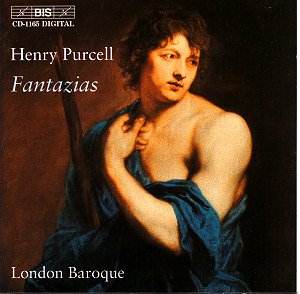When Henry Purcell was 21 years old, he wrote a series
of Fantasias for 3 to 7 viols, ostensibly as an exercise in counterpoint.
Echoes of Bachís Art of Fugue can be seen, although Purcell never intended
these works for publication, nor are they so firmly interrelated as
Bachís are by a single fugal theme. Purcell never finished this set
of works; the manuscript contains blank pages with titles referring
to more fantasias.
These works, which border on the obscure and dense,
are among the greatest works ever written for a string ensemble, and
deserve to be recognized at the same level as Beethovenís late string
quartets or some of Haydnís finest compositions. But these fantasias
lack the familiar structure of the 19th century string quartet, and
are clearly works that are akin to the many works written in England
for viol consort.
This recording by London Baroque eschews "original"
instruments and performs these pieces more as string quartets than as
consort music, playing them on violins, violas and cellos. Yet, surprisingly,
the music does not suffer from this change of instrumentation. The sound
London Baroque achieves has the same rich, lush tone as heard in a viol
consort, although it is clearly noticeable that they are not playing
viols.
Twelve of these pieces are for four instruments, though
the composition is different than a string quartet. London Baroque plays
with two violas, rather than two violins. In addition, they give three
pieces not usually included with the fantasias: a pavan, a chacony,
and a fragment of another fantasia a 4.
The music is lively and rhythmic in the F major fantasia
a 4, showing Purcellís taste for energetic compositions, but some of
the works are closer to what listeners familiar with viol consort music
would expect: slow, introspective pieces where the instruments weave
a texture of sound, where they strive more for unity than individual
lines. This recording achieves this sound brilliantly, and in no way
pales in comparison to the best recordings for viols (Jordi Savall and
Hesperion XX; Phantasm).
This beautiful disc, a recording of some of the finest
string music ever written, shows that the right performers can play
such works on "modern" instruments. London Baroque gives us
one of the finest recordings of these works, which deserve greater recognition.
Whether you are a lover of viol music, or string quartets, this disc
will show you a unique approach to this form.
Kirk McElhearn


